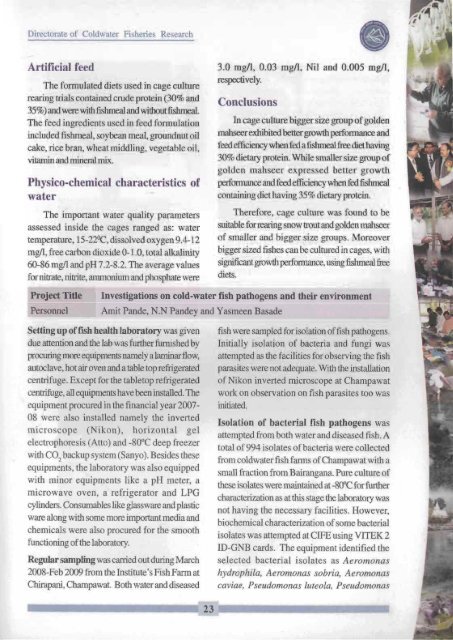You also want an ePaper? Increase the reach of your titles
YUMPU automatically turns print PDFs into web optimized ePapers that Google loves.
Directorate of Coldwater Fisheries Research<br />
Artificial feed<br />
The formulated diets used in cage culture<br />
rearing trials contained crude protein (30% and<br />
35%) and were with fishmeal and withoutfishmeaL<br />
The feed ingredients used in feed formulation<br />
included fishmeal, soybean meal, groundnut oil<br />
cake, rice bran, wheat middling, vegetable oil,<br />
vitamin and mineral mix.<br />
Physico-chemical characteristics of<br />
water<br />
The important water quality parameters<br />
assessed inside the cages ranged as: water<br />
temperature, 15-22OC, dissolved oxygen 9.4-12<br />
mgll, free carbon dioxide 0-1.0, total alkalinity<br />
60-86 mgll and pH 7.2-8.2. The average values<br />
for nitrate, nitrite, ammonium and phosphate were<br />
Project Title<br />
Personnel<br />
3.0 mgfl, 0.03 mgfl, Nil and 0.005 mgfl,<br />
respectively.<br />
Conclusions<br />
In cage culture bigger size group of golden<br />
mahseer exhibited better growth performance and<br />
feed efficiency when fed afishmeal fire diet having<br />
30% dietary protein. While smaller size group of<br />
golden mahseer expressed better growth<br />
performance and feed efficiency when fed fishmeal<br />
containing diet having 35% dietary protein.<br />
Therefore, cage culture was found to be<br />
suitable for rearing snow trout and golden mahseer<br />
of smaller and bigger size groups. Moreover<br />
bigger sized fishes can be cultured in cages, with<br />
significant growth perfonnance, using fishmeal fire<br />
diets.<br />
Investigations on cold-water fish pathogens and their environment<br />
Amit Pande, N.N Pandey and Yasmeen Basade<br />
Setting up offish health laboratory was given<br />
due attention and the lab was further furnished by<br />
procuring more equipments namely a laminar flow,<br />
autoclave, hot air oven and a table top refrigerated<br />
centrifuge. Except for the tabletop refrigerated<br />
centrifuge, all equipments have been installed. The<br />
equipment procured in the financial year 2007-<br />
08 were also installed namely the inverted<br />
microscope (Nikon), horizontal gel<br />
electrophoresis (Atto) and -80°C deep freezer<br />
with CO 2 backup system (Sanyo). Besides these<br />
equipments, the laboratory was also equipped<br />
with minor equipments like a pH meter, a<br />
microwave oven, a refrigerator and LPG<br />
cylinders. Consumables like glassware and plastic<br />
ware along with some more important media and<br />
chemicals were also procured for the smooth<br />
functioning of the laboratory.<br />
Regular sampling was carried out during March<br />
2008-Feb 2009 from the Institute's Fish Farm at<br />
Chirapani, Champawat. Both water and diseased<br />
23<br />
fish were sampled for isolation of fish pathogens.<br />
Initially isolation of bacteria and fungi was<br />
attempted as the facilities for observing the fish<br />
parasites were not adequate. With the installation<br />
of Nikon inverted microscope at Champawat<br />
work on observation on fish parasites too was<br />
initiated.<br />
Isolation of bacterial fish pathogens was<br />
attempted from both water and diseased fish. A<br />
total of 994 isolates of bacteria were collected<br />
from coldwater fish farms of Champawat with a<br />
small fraction from Bairangana. Pure culture of<br />
these isolates were maintained at -800C for further<br />
characterization as at this stage the laboratory was<br />
not having the necessary facilities. However,<br />
biochemical characterization of some bacterial<br />
isolates was attempted at CIFE using VITEK 2<br />
ID-GNB cards. The equipment identified the<br />
selected bacterial isolates as Aeromonas<br />
hydrophila, Aeromonas sobria, Aeromonas<br />
caviae, Pseudomonas luteola, Pseudomonas

















